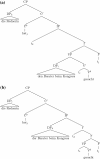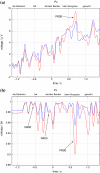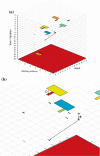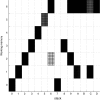Towards dynamical system models of language-related brain potentials
- PMID: 19003488
- PMCID: PMC2518748
- DOI: 10.1007/s11571-008-9041-5
Towards dynamical system models of language-related brain potentials
Abstract
Event-related brain potentials (ERP) are important neural correlates of cognitive processes. In the domain of language processing, the N400 and P600 reflect lexical-semantic integration and syntactic processing problems, respectively. We suggest an interpretation of these markers in terms of dynamical system theory and present two nonlinear dynamical models for syntactic computations where different processing strategies correspond to functionally different regions in the system's phase space.
Figures








Similar articles
-
Event-related potentials index lexical retrieval (N400) and integration (P600) during language comprehension.Brain Cogn. 2019 Oct;135:103569. doi: 10.1016/j.bandc.2019.05.007. Epub 2019 Jun 12. Brain Cogn. 2019. PMID: 31202158
-
Functional Role of the N400 and P600 in Language-Related ERP Studies with Respect to Semantic Anomalies: An Overview.Noro Psikiyatr Ars. 2021 Jan 27;58(3):249-252. doi: 10.29399/npa.27422. eCollection 2021. Noro Psikiyatr Ars. 2021. PMID: 34526850 Free PMC article. Review.
-
Verbing nouns and nouning verbs: Using a balanced design provides ERP evidence against "syntax-first" approaches to sentence processing.PLoS One. 2020 Mar 13;15(3):e0229169. doi: 10.1371/journal.pone.0229169. eCollection 2020. PLoS One. 2020. PMID: 32168357 Free PMC article.
-
A Neurocomputational Model of the N400 and the P600 in Language Processing.Cogn Sci. 2017 May;41 Suppl 6(Suppl Suppl 6):1318-1352. doi: 10.1111/cogs.12461. Epub 2016 Dec 21. Cogn Sci. 2017. PMID: 28000963 Free PMC article.
-
Neural mechanisms of language comprehension: challenges to syntax.Brain Res. 2007 May 18;1146:23-49. doi: 10.1016/j.brainres.2006.12.063. Epub 2006 Dec 23. Brain Res. 2007. PMID: 17400197 Review.
Cited by
-
Neurobehavioral Correlates of Surprisal in Language Comprehension: A Neurocomputational Model.Front Psychol. 2021 Feb 11;12:615538. doi: 10.3389/fpsyg.2021.615538. eCollection 2021. Front Psychol. 2021. PMID: 33643143 Free PMC article.
-
Dynamic searching in the brain.Cogn Neurodyn. 2009 Dec;3(4):401-14. doi: 10.1007/s11571-009-9084-2. Epub 2009 Jun 3. Cogn Neurodyn. 2009. PMID: 19496023 Free PMC article.
-
Prolegomena to a neurocomputational architecture for human grammatical encoding and decoding.Neuroinformatics. 2014 Jan;12(1):111-42. doi: 10.1007/s12021-013-9191-4. Neuroinformatics. 2014. PMID: 23872869
-
A dynamical systems perspective on the relationship between symbolic and non-symbolic computation.Cogn Neurodyn. 2009 Dec;3(4):415-27. doi: 10.1007/s11571-009-9099-8. Epub 2009 Nov 7. Cogn Neurodyn. 2009. PMID: 19898957 Free PMC article.
-
Unifying syntactic theory and sentence processing difficulty through a connectionist minimalist parser.Cogn Neurodyn. 2009 Dec;3(4):297-316. doi: 10.1007/s11571-009-9093-1. Epub 2009 Oct 1. Cogn Neurodyn. 2009. PMID: 19795221 Free PMC article.
References
-
- None
- Aho AV, Ullman JD (1972) The theory of parsing, translation and compiling, vol i: parsing. Prentice Hall, Englewood Cliffs (NJ)
-
- {'text': '', 'ref_index': 1, 'ids': [{'type': 'DOI', 'value': '10.1097/00001756-200501190-00004', 'is_inner': False, 'url': 'https://doi.org/10.1097/00001756-200501190-00004'}, {'type': 'PubMed', 'value': '15618881', 'is_inner': True, 'url': 'https://pubmed.ncbi.nlm.nih.gov/15618881/'}]}
- Allefeld C, Frisch S, Schlesewsky M (2004) Detection of early cognitive processing by event-related phase synchronization analysis. NeuroReport 16(1):13–16 - PubMed
-
- {'text': '', 'ref_index': 1, 'ids': [{'type': 'PubMed', 'value': '4850221', 'is_inner': True, 'url': 'https://pubmed.ncbi.nlm.nih.gov/4850221/'}]}
- Amari SI (1974) A method of statistical neurodynamics. Kybernetik 14:201–215 - PubMed
-
- {'text': '', 'ref_index': 1, 'ids': [{'type': 'DOI', 'value': '10.1007/BF00337259', 'is_inner': False, 'url': 'https://doi.org/10.1007/bf00337259'}, {'type': 'PubMed', 'value': '911931', 'is_inner': True, 'url': 'https://pubmed.ncbi.nlm.nih.gov/911931/'}]}
- Amari SI (1977) Dynamics of pattern formation in lateral-inhibition type neural fields. Biol Cybernet 27:77–87 - PubMed
-
- {'text': '', 'ref_index': 1, 'ids': [{'type': 'DOI', 'value': '10.1037/0033-295X.111.4.1036', 'is_inner': False, 'url': 'https://doi.org/10.1037/0033-295x.111.4.1036'}, {'type': 'PubMed', 'value': '15482072', 'is_inner': True, 'url': 'https://pubmed.ncbi.nlm.nih.gov/15482072/'}]}
- Anderson JR, Bothell D, Byrne MD, Douglass S, Lebiere C, Qin Y (2004) An integrated theory of the mind. Psychol Rev 111(4):1036–1060 - PubMed
LinkOut - more resources
Full Text Sources

